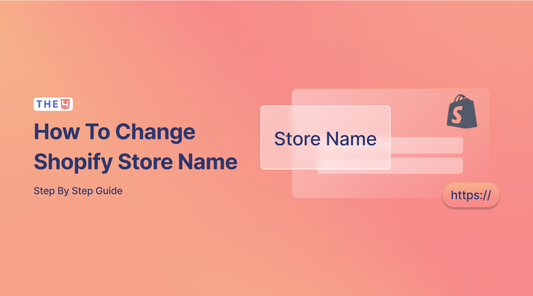Table Of Content
Shopify vs Squarespace: Which Is Better for Your Business?

In the rapidly expanding digital world, businesses need a robust and reliable platform to establish and grow their online presence. Two industry leaders, Shopify and Squarespace, offer an array of features designed to support this very need. As both platforms have distinctive advantages, selecting between them often becomes a critical business decision.
In this blog, we will compare the differences between Shopify and Squarespace, and analyze their pros and cons. Before going into the details, make sure you have built an eCommerce store on Shopify!
What is Shopify?

Founded in 2006, Shopify has carved out a place for itself as a leading figure in the e-commerce landscape. Its role is to empower businesses, regardless of size, to establish comprehensive online storefronts effortlessly. The platform offers an array of services to streamline online business operations, encompassing aspects like payment processing, marketing, and shipping, and customer engagement.
Shopify's user-friendly interface distinguishes it from competitors, enabling store owners to manage their online shops seamlessly. This includes everything from store customization, product management, order tracking, to inventory control. The platform's collection of themes and apps enhance a store's functionality and design, allowing businesses to shape their storefronts to reflect their brand identity. Additionally, the ability to integrate with various social media platforms and marketplaces offers a broader customer reach. With over 4.12 million e-commerce websites powered by Shopify, its efficacy and dependability are clearly demonstrated.
What is Squarespace?

Squarespace is a well-regarded, subscription-based platform that facilitates the creation of websites and online stores. Established in 2003, Squarespace provides a comprehensive suite of services, including web design, e-commerce capabilities, blogging tools, and marketing integrations. Its mission is to streamline the online presence management process, making it an invaluable tool for small to medium-sized businesses.
The platform is renowned for its intuitive and user-friendly interface, making the task of customizing online spaces, organizing offerings, and managing inventory seamless for users. Alongside its functionality, Squarespace is known for its visually impressive and customizable templates, designed to suit a multitude of brand aesthetics.
Beyond its core features, Squarespace provides a selection of apps and integrations to amplify a website's functionality. It also supports direct product selling via social media platforms or marketplaces through various integrations. With millions of websites worldwide built using Squarespace, it has earned a reputation as a reliable, efficient, and aesthetically appealing platform for creating and managing an online presence.
What are similarities and differences between Shopify and Squarespace?

Similarities between Shopify and Squarespace
Navigating the complexities of Shopify and Squarespace, we find several commonalities that these platforms share. Let's proceed to a detailed analysis of these shared characteristics to gain a deeper understanding of their similarities.
- Ease of Use: Both platforms have intuitive, user-friendly interfaces. They've been designed to make it easy for anyone, even those with little to no coding experience, to create beautiful, functional websites.
- Template Variety: Shopify and Squarespace provide a wealth of professionally designed, responsive templates. These designs cater to a wide array of industries and aesthetic preferences, allowing businesses to create unique, engaging digital storefronts.
- Built-in E-commerce Functionality: Both platforms are equipped with powerful e-commerce capabilities. They offer tools for product listing, inventory management, shopping cart functionality, and easy checkout processes.
- SEO-Friendly: Shopify and Squarespace understand the importance of SEO in today's digital landscape. Both platforms provide SEO tools to help improve your website's visibility on search engines, including customizable URLs, meta titles, and descriptions, as well as alt tags for images.
- Mobile Optimization: Both platforms prioritize mobile responsiveness, ensuring that websites look and function excellently on any device. This is crucial as an increasing number of consumers shop on mobile devices.
- Customer Support: Shopify and Squarespace provide robust customer support, offering resources such as 24/7 live chat, email support, community forums, and extensive knowledge bases.
- Social Media Selling: Both Shopify and Squarespace support selling on social media platforms. This multi-channel selling approach allows businesses to reach more customers and increase sales.
Differences between Shopify and Squarespace
1. Pricing
* Shopify:

Shopify prides itself on offering a diverse range of plans to suit businesses of all sizes and budgets. Here's a brief rundown:
- Basic plan: The Basic Shopify plan, costing $29 monthly, serves as an excellent choice for small-scale businesses looking to break into the e-commerce sphere. It offers a robust set of features, including around-the-clock customer support, a variety of themes, and a powerful editing tool.
- Standard plan: For merchants seeking more, Shopify's Standard plan offers more advanced features for $79 monthly. Beyond everything included in the Basic package, you'll gain access to comprehensive reporting tools and the capability to recover abandoned carts—a feature that can significantly increase your sales and offset the additional cost.
- Advanced plan: For larger businesses with more comprehensive needs, Advanced Shopify comes in at $299 monthly. This level introduces even more sophisticated reporting and real-time shipping rates.
It's worth mentioning that Shopify rewards those ready to make a long-term commitment. They offer yearly plans that can lead to considerable savings. For example, you could save as much as $1,200 if you choose to prepay for a year of the Advanced Shopify plan! This makes a longer commitment a smart move if Shopify aligns with your business needs.
Also, remember that Shopify provides a 3-day trial period for you to get a feel for its features. So, with plans to fit every pocket and a robust feature set to match, Shopify's pricing can easily be justified by the potential return on investment you stand to gain. To top it all off, Shopify is currently offering a special promotion, where you can start your store for just $1 a month on selected plans.
* Squarespace:

Squarespace provides a versatile pricing structure, which includes four distinct plans to cater to various business needs: Personal, Business, Basic Commerce, and Advanced Commerce. Each plan offers an incremental set of features with prices ranging from $16 to $49 when billed annually.
- Personal Plan: Priced at $16 per month, the Personal Plan is suitable for individuals or small businesses that require a basic online presence. However, it lacks eCommerce capabilities, making it less suitable for businesses looking to sell products or services online.
- Business Plan: For $26 per month, the Business Plan offers full eCommerce functionality, alongside other advanced features. However, it's important to note that Squarespace charges an additional 3% transaction fee for sales made on this plan, which can add up for high-volume sellers.
- Basic Commerce: At $30 per month, the Basic Commerce plan removes the 3% transaction fee and adds a host of eCommerce-specific features such as customer accounts and on-domain checkout processes. It's ideal for small to medium-sized businesses looking to set up an online store.
- Advanced Commerce: The most comprehensive offering from Squarespace is the Advanced Commerce plan. Priced at $46 per month, it includes all the features of the Basic Commerce plan and adds advanced shipping, discounts, and analytics features. This plan is best suited for larger businesses with higher sales volumes.
For those who wish to 'try before they buy,' Squarespace offers a free trial period, allowing you to assess the platform and its capabilities.
It's important to note, however, that the Personal plan lacks eCommerce and Marketing features. Therefore, if your aim is to establish a commercial presence using Squarespace, you will need to opt for one of the three other plans. Be aware that the Business plan imposes an additional transaction fee of 3%, a fee not present in the other two plans. This could result in substantial added costs, depending on your sales volume.
2. Ease of Use
Navigating the backend of your online store should be smooth and intuitive. Shopify is well-known for its user-friendly interface that makes it easy for even beginners to set up their online store. Their dashboard is straightforward, and the entire process, from adding products to managing orders, is streamlined and efficient.
Squarespace, while user-friendly, is designed with a strong focus on aesthetics and might require a steeper learning curve, particularly for those new to website building. The platform offers an array of sophisticated design tools which can seem overwhelming at first, but once mastered, allow for extensive customization.
3. Design and Customization
When it comes to design, Squarespace shines with its assortment of stylish, modern templates. Their focus on design-forward aesthetics means every template is created with meticulous attention to detail. You can extensively customize these templates to match your brand, although doing so might require a learning curve.
On the other hand, Shopify's approach to design emphasizes functionality. The platform provides various themes, all of which are designed to support effective e-commerce. While they might not match the visual sophistication of Squarespace's templates, they are highly customizable within the realm of enhancing e-commerce operations.
4. ECommerce Features
Shopify excels in its comprehensive suite of e-commerce features. From product management and inventory tracking to sophisticated sales features and analytics, Shopify provides everything an online business might need to thrive. The platform is built to scale and can handle significant traffic and transaction volume without compromising site performance.
Contrarily, Squarespace's e-commerce capabilities are somewhat more basic. They cover the essentials - product listings, payment processing, and simple analytics. However, they lack some of the advanced features that Shopify offers, making Squarespace a better fit for smaller businesses or those that do not primarily focus on e-commerce.
5. SEO and Marketing Tools
Shopify and Squarespace both offer a suite of SEO and marketing tools, albeit with differing levels of comprehensiveness and emphasis. In the arena of Search Engine Optimization, Shopify comes out ahead with its robust features aimed at boosting your online store's visibility. It facilitates easy editing of meta tags, creation of SEO-friendly URLs, and the auto-generation of a sitemap.xml, simplifying the crawling process for search engines. The analytics feature of Shopify also plays a crucial role, offering valuable insights into your store's performance and paving the way for informed decision-making.
In the realm of marketing tools, Shopify continues to shine with a variety of offerings. These include email marketing integrations, social media advertising, and synchronization with Google Shopping. The advanced marketing dashboard is an asset, allowing you to monitor campaigns, track performance, and fine-tune strategies accordingly. Further, Shopify's rich app ecosystem provides a plethora of SEO and marketing apps, opening doors to specialized SEO enhancement and comprehensive marketing automation tools.
In contrast, Squarespace, while offering essential SEO tools, inclines more toward the visual facet of SEO. It places considerable emphasis on image optimizations and mobile-friendly design - both significant ranking factors. It also supports meta tags editing and clean URL generation but falls short when compared to the expansive SEO offerings of Shopify.
In terms of marketing, Squarespace provides fundamental tools such as email campaigns and social media integration, along with some built-in analytics. However, these tools are relatively basic when juxtaposed with Shopify's comprehensive marketing features. Thus, while Shopify might be more appealing to an online store prioritizing growth and increased conversions, Squarespace could be suitable for smaller businesses or those desiring a less complex marketing strategy.
6. Customer Support and Resources
When running an online business, effective and reliable customer support can make a significant difference. On this front, both Shopify and Squarespace provide commendable services, but there are nuances in their approaches that could swing your preference.
Shopify offers a wide array of customer support options, tending to be a frontrunner in this regard. The platform provides round-the-clock support via phone, live chat, and email - a massive relief for store owners who might encounter issues at any time of the day. Furthermore, Shopify maintains a comprehensive knowledge base, offering in-depth tutorials, guides, and FAQs. These resources cover a broad range of topics, enabling users to find answers to common questions and learn more about using the platform. Moreover, Shopify provides forums where users can share experiences and insights, fostering a community-based learning environment.
On the other hand, Squarespace provides robust customer support, although it doesn't offer the 24/7 phone support that Shopify does. They offer 24/7 email support and live chat support on weekdays during specified hours. However, Squarespace's help center is quite comprehensive, featuring a multitude of guides, tutorials, and videos. Additionally, they offer community forums and conduct regular webinars for interactive learning and problem-solving. While Squarespace's customer support is quite solid, businesses that require constant, immediate support might lean toward Shopify's more exhaustive support services.
7. Integration and Add-ons
In an increasingly interconnected digital landscape, the ability of your e-commerce platform to integrate with various apps and add-ons can be a game changer. These integrations enhance your store's functionality, add new features, and streamline your workflow.
Shopify has one of the most robust app ecosystems in the e-commerce industry, allowing Shopify to offer virtually unlimited scalability and customization. Regardless of your needs, there's a good chance there's a Shopify app to meet those needs.
Squarespace, on the other hand, doesn't have an app store like Shopify. However, they do offer a selection of extensions that provide additional functionality to your site. These extensions cover key areas like shipping, inventory, accounting, and more. Squarespace's approach offers less volume than Shopify but ensures that the extensions available are reliable, high-quality, and integrate seamlessly with the platform. Although the options are fewer, Squarespace's integrations can fully meet the needs of many small and medium businesses.
Which Is Better: Squarespace or Shopify?

In order to assist you in determining the most suitable platform for your needs, we've compiled a comparative analysis of the advantages and disadvantages of both Shopify and Squarespace. We hope that this comparison will provide you with the necessary insights to make an informed decision.
|
Shopify |
Squarespace |
|
|
Pros |
- Shopify offers an easy-to-use editor that simplifies the process of setting up and managing your online store. - Shopify stands out for its excellent range of e-commerce features, giving you the tools you need to run a successful online store. - With Shopify, you can easily sell across multiple social channels, enhancing your reach and customer engagement. - Shopify boasts a robust app store, providing numerous extensions and add-ons that can further enhance your online store's functionality. |
- Squarespace stands out for its sleek, modern templates that can instantly give your website a polished, professional look. - Squarespace offers various pricing plans that cater to different budget ranges, making it an affordable choice for businesses of all sizes. |
|
Cons |
- Shopify enforces additional transaction fees if you choose to use payment methods other than Shopify Payments. - It switches your theme necessitates a content reformat, which can be time-consuming - Despite its user-friendly interface, it lacks the sheer simplicity of drag-and-drop platforms. But you can always use third-party apps like EComposer - Landing Page Builder |
- Unlike Shopify, Squarespace lacks a dedicated app store and instead has an extension market, potentially limiting the enhancement options for your site. - Squarespace supports fewer payment options compared to some competitors, which could restrict convenience for some customers. - While Squarespace's dashboard is powerful and feature-rich, it may present a learning curve for beginners. |
Please note that this table is a simplification, and the decision between Shopify and Squarespace should be based on the specific needs and circumstances of your business. Both platforms have their strengths, and what works best will depend on factors such as your budget, your technical skill level, the size of your store, and the specific features that you require.
Frequently Asked Questions
1. Why use Shopify over Squarespace?
When it comes to e-commerce capabilities, Shopify tends to outperform Squarespace. This platform equips users with a plethora of exceptional features, such as comprehensive analytics, point-of-sale (POS) systems, and sophisticated marketing tools. Importantly, Shopify excels in scalability, capable of handling an increased volume of orders without causing any lag on your website.
Conversely, Squarespace can be an ideal choice for those who prioritize creative control and flexibility in designing a website, with e-commerce functionalities being a secondary consideration.
2. Do Squarespace and Shopify work together?
Certainly. If you're a Shopify store owner, you can seamlessly integrate it with your Squarespace website or domain. This allows for efficient multi-platform selling, giving your products more exposure. Moreover, you can utilize your Squarespace site to promote your Shopify store, directing visitors to explore your product offerings. Essentially, this integration optimizes your online presence and potentially increases sales by leveraging the strengths of both platforms.
3. Is Squarespace good for dropshipping?
Yes, Squarespace can be a beneficial platform for drop shipping. It offers a visually appealing interface and user-friendly design tools, which can create an attractive and engaging storefront for your customers. Even though it might not have the most comprehensive e-commerce functionalities compared to some specialized e-commerce platforms, its compatibility with various third-party dropshipping solutions enhances its capabilities. Therefore, Squarespace could be a viable choice for your business if you prioritize a clean and visually compelling storefront, alongside the dropshipping model for your products.
4. Does Shopify take a cut/have discount?
Yes, Shopify takes a cut from transactions made through its platform. This transaction fee is part of the cost of using the service. The specific percentage or amount taken by Shopify can vary depending on your subscription plan.
In terms of discounts, Shopify typically offers incentives for those who choose to commit to their services long-term. For instance, if you opt to pay for your Shopify plan annually or biennially, you could receive a significant discount.
As mentioned above Shopify is having a free trial program and opening your Shopify store for $1/month (available for some plans).
5. Can I switch from Squarespace to Shopify?
Yes, you can transition from Squarespace to Shopify. This involves a process of data migration, SEO maintenance through 301 redirects, and site re-design on the new platform. It's essential to back up your data before moving and to familiarize yourself with Shopify's interface afterward.
In a nutshell,
The choice between Shopify and Squarespace boils down to your specific business needs and goals. Shopify is the perfect choice for those who prioritize comprehensive e-commerce capabilities. On the other hand, Squarespace tends to be the go-to for users who value ease of use and beautiful designs.
Regardless of the platform you choose, remember that the key is to consider how its strengths align with your business model and growth aspirations. The ideal platform not only establishes your online presence but also supports your business's growth and evolution.
We hope this blog has helped you in choosing a platform to start your business with. If you want more information or want to learn more about EComposer, follow us at ecomposer.io or click on the message icon located in the right corner of the screen.
=================
Add EComposer Next generation page builder Here
Follow Us on Facebook
Join Official Community













No comments